Headspace’s Fifth Annual Workforce Attitudes Toward Mental Health report reflects on recent advancements in support and identifies new challenges to tackle. From perpetual ‘Sunday scaries’ and elevated stress about traumatic global events to mounting pressures on HR professionals, the report unveils the realities of employee mental health in 2023.

This article offers actionable insights for proactively addressing employee concerns, fostering improved mental well-being, and balancing transparency and hope amidst uncertainty and instability.
Pressed for time? Here’s a quick summary…
- Employees feel a growing sense of work-related dread due to job instability, more responsibilities, and greater expectations in the workplace.
- DEIB initiatives can offer support networks and resources to help employees cope with external events that impact employee mental health.
- HR professionals struggle to maintain their own mental well-being while emotionally supporting their peers.
- There is a disconnect between employers who prioritize positivity and employees who crave transparency.
- CEOs bear the brunt of workplace dread, underscoring the importance of mental health practices for their well-being and healthier team dynamics.
Overcoming Workplace Dread: Struggles Amidst Instability, Pressure, & Rising Expectations
While pandemic-induced stress has subsided for some employees, a more prominent issue is emerging: workplace dread.
Eighty-seven percent of employees feel dread at least once a month, with almost half experiencing it weekly. The problem worsens for leadership, with 55% of executives and 59% of CEOs reporting dread every week.
The primary reasons for feelings of dread include:
- Job instability (45%)
- Increased responsibilities (45%)
- Heightened expectations (42%)
Layoffs have left remaining employees with additional work and the emotional stress of losing a teammate, not to mention the fear of being the next to go.
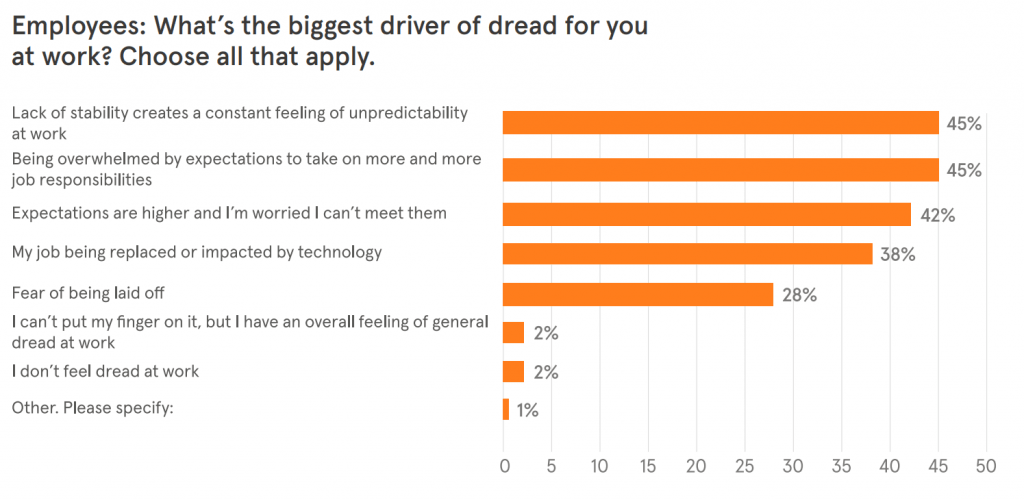
Managers play a key role in employee mental health. Behaviors such as disrespect for working hours (42%), ignoring life outside of work (40%), and setting an unsustainable workload (38%) contribute to employee mental health issues. On the other hand, half of the employees reported that flexibility with schedules and assignments to accommodate personal issues positively impacts their mental health.
Action Steps
The feeling of anxiety or dread about returning to work on Monday, commonly known as the ‘Sunday scaries,’ has become a perpetual burden for employees, significantly affecting their job satisfaction and mental well-being. This catchphrase, deeply ingrained in pop culture, highlights the widespread nature of this phenomenon. How can organizations combat this prevailing sense of dread?
- Define Roles & Encourage Flexibility: Ensure employees have clearly defined job expectations and consider implementing flexible work arrangements. Welcome open communication by encouraging employees to voice concerns and seek clarifications without fear of reprisal.
- Promote Purpose: Regularly reiterate the “why” behind work by communicating how employees’ duties align with the organization’s mission or the overarching goals of their department. A strong sense of purpose improves employee retention while contributing to overall health and happiness, both in and out of the workplace.
- Practice “Ruthless Prioritization”: Ask, “What’s the risk of not prioritizing this task?” to evaluate the importance of each initiative. By challenging each task’s value, workloads can be approached with more intention. This helps employees manage their responsibilities more effectively, ultimately reducing stress.
- Prioritize Mental Health: Developing a workplace culture that prioritizes mental health begins with providing robust mental health benefits. This reduces the stigma associated with mental illness and equips employees with the coping mechanisms necessary for navigating any challenges harming their well-being.
- Model Self-Care: Leaders must set clear work-life boundaries, schedule time for self-care, and encourage their team to follow suit. By prioritizing mental health as leaders, employees feel empowered to radically invest in their wellness.
Harnessing The Power Of Diversity, Equity, Inclusion, & Belonging
The vital role of diversity, equity, inclusion, and belonging (DEIB) in shaping organizational policies and culture is increasingly apparent. These efforts positive influence marginalized communities and the broader workforce alike.
More than half of employees believe that their employer’s DEIB policy positively affects their mental health. This sentiment is especially prominent among marginalized groups. Non-binary employees, for instance, are more likely to say they are positively impacted by their company’s DEIB policy (75%).
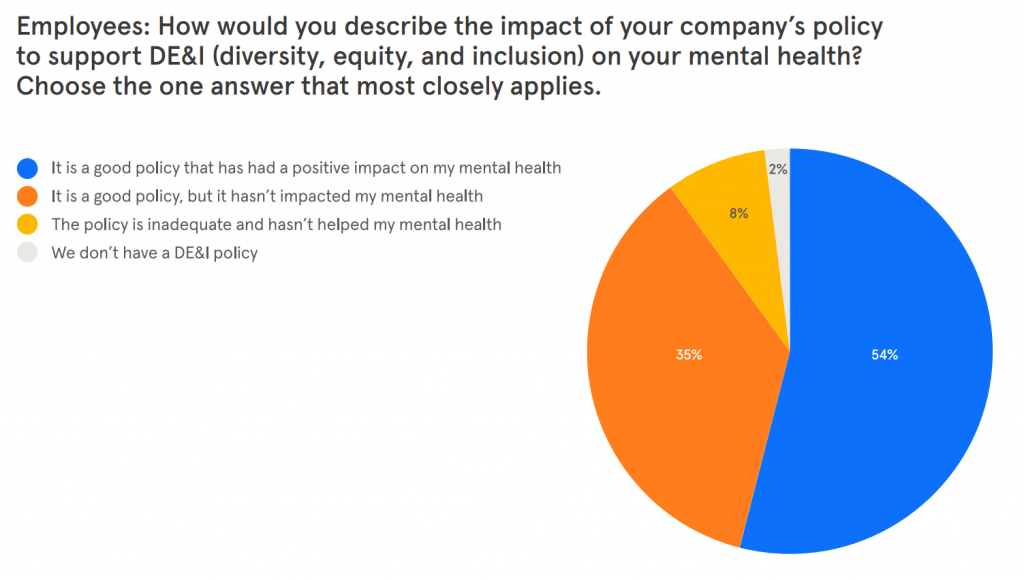
Addressing the intersectionality of mental health is essential. This involves understanding how an individual’s social and political identities shape their experiences, particularly in terms of privilege and discrimination. Traumatic global events influence 97% of employees’ mental health at work, with 40% citing economic uncertainty as a significant factor impacting their well-being. Whether related to war, violence, or economic instability, global trends hinder employees’ ability to be fully present based on their identity and lived experiences. DEIB initiatives are crucial to effectively respond to polarizing events and provide the necessary support.
Action Steps
While there has been significant progress with DEIB initiatives, there is still work to be done. How can organizations continue promoting DEIB in the workplace?
- Revise Non-Discrimination Policies: Organizations should periodically review and update non-discrimination policies to reflect the evolving social climate and ensure complete inclusivity. For example, explicitly including gender identity, sexual orientation, and expression in such policies demonstrates a company’s commitment to DEIB initiatives with specific regard to LGBTQI+ employees.
- Train Managers To Discuss Race & Identity: Educate managers about how to talk about race and identity with respectful, empathetic, and constructive dialogue. By fostering an environment that values and embraces identity differences, employers empower employees to be their authentic selves and stress less on the job.

- Embed DEIB In Communications: Incorporate a DEIB perspective in all communications, including website content, social media, and marketing campaigns. Prioritize diverse viewpoints, inclusive language, and accessible content. Move beyond a check-the-box approach to DEIB and treat it as an integral part of the organization’s strategy.
- Establish Inclusive Meeting Protocols: Consider the accessibility of meetings for employees with disabilities. Develop protocols that promote equitable participation and ensure everyone’s voices are heard. This creates an inclusive and accepting environment, resulting in more positive and effective meeting dynamics.
- Weave DEIB Into Wellness Programs: While wellness programs and DEIB initiatives are often disconnected, organizations can take steps to ensure their wellness efforts provide all populations with an equal opportunity to thrive. This includes partnering with diverse wellness vendors, utilizing inclusive promotional materials, and providing inclusive and accessible benefits. Fertility benefits, for instance, are particularly important for LGBTQI+ employees who plan to use assisted reproductive technology, surrogacy, or adoption to expand their families.
Nurturing HR Leaders: Prioritizing Support & Well-Being
In the face of ongoing layoffs and rapid workplace changes, HR professionals take the brunt of employee stress. Their dread stems not only from struggling to manage their own growing responsibilities but also from the unspoken expectation of serving as emotional support pillars for other employees.
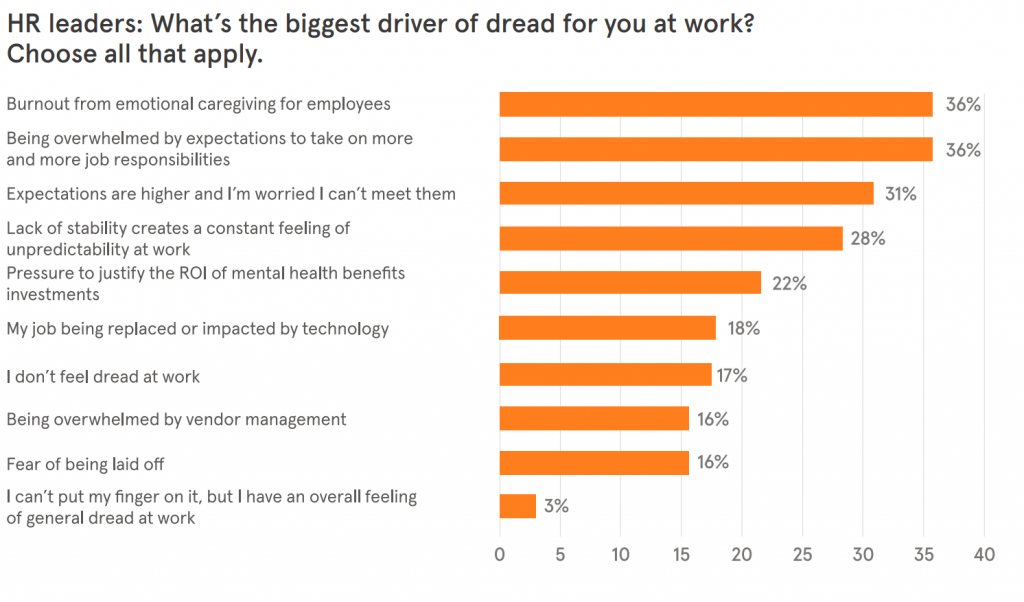
Despite these demands, HR leaders underutilize mental health resources compared to other groups, with only 41% using these benefits regularly. This is significantly lower than CEOs (64%) and other employees (73%). As a result, HR professionals struggle to sustain their mental well-being while bearing the responsibility of fostering mental health in the workplace.
Action Steps
HR professionals work tirelessly to tackle challenges, drive growth, and support organizational success. Amidst endless responsibilities, how can they be better supported?
- Self-Care Comes First: Just as any leader should model self-care to shape organizational culture, HR leaders must also practice filling their own cup first. This means prioritizing their well-being and replenishing their energy before tending to the needs of others. Reflect on systems that could ease the burdens of the HR team, such as reducing meetings during high-pressure periods like Open Enrollment.
- Offer Specific Support: Being overwhelmed can make it difficult to ask for help. Rather than requesting vague support, HR leaders can ask themselves, “What is one specific thing that would make my week easier?” This encourages them to pinpoint their needs and confidently seek out the necessary support.
- Establish Emotional Boundaries: To mitigate compassion fatigue, HR leaders could benefit from having a simple mantra that helps them maintain perspective during emotionally charged discussions. For example, psychologist Dr. Karyn D. Hall recommends repeating, “This is their experience, not mine,” to stay grounded.
Balancing Leadership & Authenticity: The Stress Of CEO Positivity
Nearly half of CEOs believe displaying positivity is more important than communicating difficult truths to their team. This can lead to employee confusion and anxiety regarding job security and the company’s stability.
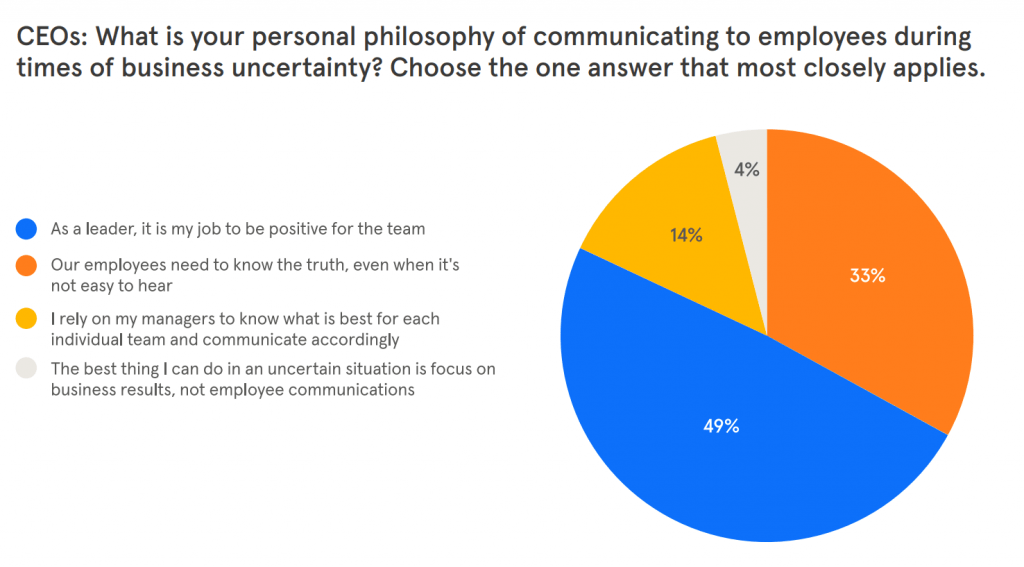
With ongoing economic uncertainty, 75% of employees fear their company will cut back on mental health support and benefits if there is a recession. However, 64% of CEOs plan to increase mental health benefits in a recession.
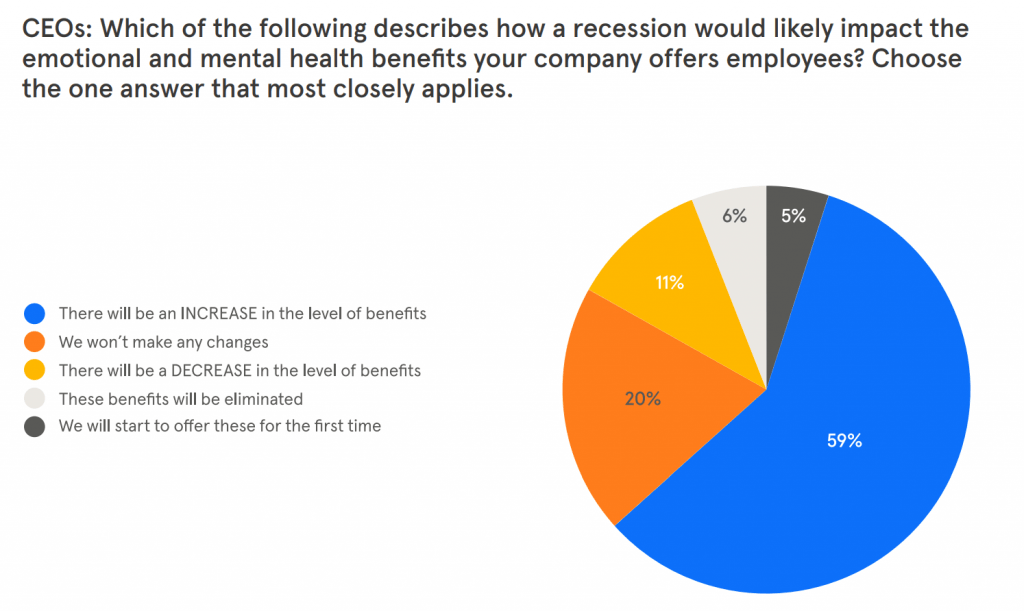
Action Steps
The communication gap is clear: ambiguity and perpetual positivity are creating stress among employees who crave transparency in uncertain times. How can organizations fix this disconnect?
- Create A Space To Discuss The Company’s Status: Create opportunities for honest discussion about the state of the organization. Encourage the team to ask questions through an “Ask Me Anything” session and share transparently, eliminating ambiguity and uncertainty.
- Establish A Communication Mindset: For CEOs and other leaders, preparing intentions before interacting with the team can foster transparency and effective delivery. Some qualities to aim for could be clarity, directness, and compassion.
Aligning CEO & Employee Sentiments: The Changing Landscape Of Mental Health Awareness
Mental health awareness in the workplace has seen a noteworthy shift, with the divide between CEOs’ and employees’ perceptions of mental health support narrowing significantly. An encouraging 91% of CEOs and 89% of employees agree that their company provides adequate mental health support, compared to 94% and 67% in 2022, respectively. This alignment can be attributed to CEOs proactively breaking the silence around mental health.
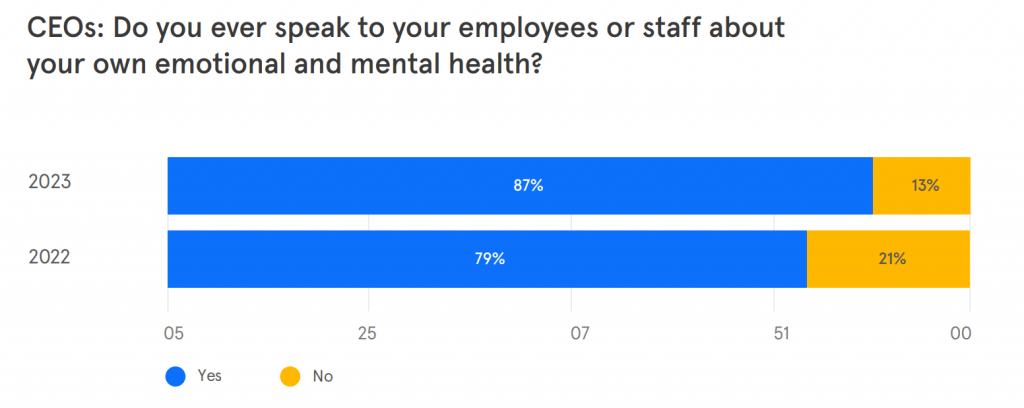
CEOs are also walking the walk, with 92% engaging in self-care habits and 64% regularly utilizing mental health benefits.
Unfortunately, nearly 60% of CEOs continue experiencing dread at work weekly, more than any other group surveyed. Thirty-five percent of these leaders fail to leverage mental health benefits, despite over half of CEOs asserting the need for increased mental health support due to factors such as:
- Market volatility
- Inflation
- Widespread burnout
Action Steps
Despite the encouraging shift towards mental health awareness, CEOs still endure weekly work-related dread and underutilize mental health benefits. How can organizations promote CEO participation in mental health practices and set a healthier tone for their teams?
- Create Space For Vulnerability: When leaders authentically share their mental health journeys and the self-care strategies they’ve employed, employees feel at ease sharing their experiences and seeking help. While it’s important to maintain the essential boundaries between personal and professional spheres, the team remains a supportive network for mental wellness in the workplace.

- Treat Mental Health As A Preventive Measure: Approach mental health maintenance as a preventive measure rather than a reactive one. Consistently integrating practices that support mental health builds resilience in employees during challenging times. This can include:
- Encouraging regular stretch breaks or short walks throughout the workday
- Allowing employees to take “mental health” days off work
- Beginning team meetings with a mindfulness exercise
- Checking in on team members’ well-being regularly
- Providing stress-management resources and workshops
Dr. Dana Udall, Chief Clinical Officer of Headspace, provides insight into how managers can play a role in supporting mental health in the workplace:
“People are often reluctant to discuss their mental health challenges, especially at work. And though we should ensure that managers aren’t being asked to act as therapists, managers can play a powerful role in supporting employee mental health in a few key ways.
They can use active listening skills to create psychological safety and help the employee feel understood; they can route employees to relevant mental health resources; and they can share any tips and tricks they use to care for their own mental health, from meditating to setting boundaries around work to seeking help from mental health professionals.
These actions send employees a clear message: you’re not alone and it’s okay to ask for help.”












